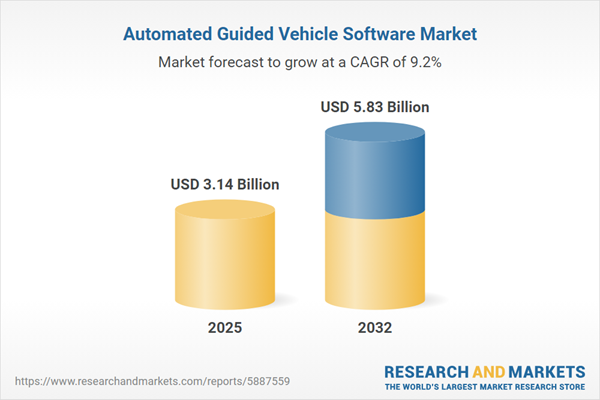Speak directly to the analyst to clarify any post sales queries you may have.
Automated guided vehicle software is rapidly advancing supply chain efficiency, providing senior decision-makers with the strategic automation tools needed to modernize logistics operations and meet challenging market demands. By embracing this software, organizations strengthen adaptability and future-proof their logistics networks through data-driven automation and enhanced coordination.
Market Snapshot: Automated Guided Vehicle Software Market
The automated guided vehicle software market continues to achieve steady growth, propelled by increased adoption across sectors seeking resilient and agile supply chains. This momentum is attributed to a global emphasis on digital transformation across manufacturing, healthcare, logistics, and e-commerce. Enterprises are allocating resources to advanced automation platforms to unlock operational visibility and improve reliability, reinforcing initiatives aligned with Industry 4.0. Leading software solutions focus on orchestrating logistics workflows, raising benchmarks for responsiveness and quality assurance in day-to-day operations. Organizations are deploying this technology to adapt to new market dynamics, with software investments now viewed as vital components for sustaining competitiveness and stability in unpredictable commercial environments.
Scope & Segmentation
- Application Industry: E-commerce and retail sectors leverage automated guided vehicle software to expedite deliveries and enable distributed and responsive fulfillment models. Food and beverage companies prioritize these technologies to support compliance and maintain quality during sensitive packaging or handling stages. Healthcare providers implement automation for robust inventory tracking and to satisfy stringent regulatory standards. Logistics firms benefit from improved fulfillment accuracy and optimized sorting, and manufacturers in automotive, electronics, and pharmaceuticals use automation to boost throughput and production efficiency across complex operations.
- Software Type: Fleet management software offers real-time monitoring and vehicle control, while navigation modules optimize routing and support adaptive responses to changing conditions. Path planning tools drive flexible operations, and safety systems enhance compliance and minimize risk, supporting reliable and secure fleet activities.
- Deployment Mode: Cloud-based platforms deliver centralized oversight, analytics, and scaled management across distributed sites, while on-premise solutions offer custom integration and strong data control tailored to meet specific infrastructure or compliance demands.
- Enterprise Size: Large enterprises implement comprehensive automation for managing extensive logistics networks, whereas small and mid-sized companies seek scalable, modular platforms that align with targeted growth and operational efficiency objectives.
- Regional Coverage: The Americas concentrate on innovation in warehousing and distribution, EMEA emphasizes system integration and regulatory compliance, and the Asia-Pacific region invests in logistics technology and expanding infrastructure to accelerate manufacturing and streamlined goods movement.
- Leading Companies Profiled: Prominent market participants such as Daifuku Co., Ltd., KION Group AG, Toyota Industries Corporation, Murata Machinery, Ltd., Honeywell International Inc., JBT Corporation, OMRON Corporation, Zebra Technologies Corporation, KUKA AG, and ABB Ltd. are highlighted for their differentiated approaches and advancing technology leadership.
Key Takeaways for Senior Decision-Makers
- Integrating artificial intelligence within control systems delivers significant agility for logistics, enabling organizations to manage complex networks using data-driven strategies.
- Advanced software integration with warehouse management, ERP, and IoT platforms provides transparency, supporting rapid responses to changing conditions or unexpected disruptions.
- Adoption of cloud-based automation improves analytics and planning for globally distributed teams, equipping organizations to adapt quickly and efficiently in dispersed operations.
- Investments in cybersecurity and advanced safety applications are pivotal for regulatory compliance and minimizing operational risk, crucial in healthcare and other regulated sectors.
- Collaboration between software developers and hardware providers results in solutions tailored to industry-specific challenges, allowing organizations to address niche logistical demands with precision.
Tariff Impact: Navigating Regulatory Dynamics
Alterations to tariff frameworks, particularly within the United States, are reshaping sourcing and vendor alliance strategies for automated guided vehicle software. Vendors are responding by establishing regional partnerships, diversifying licensing models, and enhancing compliance resources. These actions foster supply chains that remain adaptive and transparent as regulatory landscapes evolve.
Methodology & Data Sources
This report integrates comprehensive secondary research with targeted insights from technology leaders and operational experts. All conclusions are rigorously validated, ensuring that decision-makers receive current and reliable intelligence for strategic planning.
Why This Report Matters
- Gives leaders actionable insights for navigating evolving regulatory and operational environments through targeted automation investments.
- Supplies practical criteria and best-practice guidance for selecting, evaluating, and implementing automated guided vehicle software tailored by industry segment and enterprise need.
- Prepares organizations to effectively assess risks and capitalize on opportunities when introducing adaptive automation technologies into competitive, ever-changing supply chains.
Conclusion
Automated guided vehicle software empowers organizations to enhance supply chain resilience and scalability, positioning enterprises to adapt to ongoing transformation and sustain readiness in a rapidly shifting logistics environment.
Additional Product Information:
- Purchase of this report includes 1 year online access with quarterly updates.
- This report can be updated on request. Please contact our Customer Experience team using the Ask a Question widget on our website.
Table of Contents
3. Executive Summary
4. Market Overview
7. Cumulative Impact of Artificial Intelligence 2025
Companies Mentioned
The companies profiled in this Automated Guided Vehicle Software market report include:- Daifuku Co., Ltd.
- KION Group AG
- Toyota Industries Corporation
- Murata Machinery, Ltd.
- Honeywell International Inc.
- JBT Corporation
- OMRON Corporation
- Zebra Technologies Corporation
- KUKA AG
- ABB Ltd.
Table Information
| Report Attribute | Details |
|---|---|
| No. of Pages | 195 |
| Published | November 2025 |
| Forecast Period | 2025 - 2032 |
| Estimated Market Value ( USD | $ 3.14 Billion |
| Forecasted Market Value ( USD | $ 5.83 Billion |
| Compound Annual Growth Rate | 9.2% |
| Regions Covered | Global |
| No. of Companies Mentioned | 11 |









